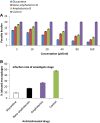Nano amphotericin B: a good anti-leishmanial drug with effect on cathelicidin gene expression
- PMID: 34295035
- PMCID: PMC8254690
- DOI: 10.1007/s12639-020-01308-3
Nano amphotericin B: a good anti-leishmanial drug with effect on cathelicidin gene expression
Abstract
Protozoan parasites, such as Leishmania major (L. major), remained as a global health problem of the current century. Leishmania major is a major cause of cutaneous leishmaniasis (CL) in developed and developing countries. Traditionally, amphotericin B is prescribed as an alternative drug, while first-line drugs failed. Some active proteins of the innate immune system such as cathelicidins try to inhibit infection Via several proposed mechanisms. Here this research aimed to not only determine the anti-leishmanial activity of nano amphotericin B but also to evaluate which anti-leishmanial drug can induce the cathelicidin gene expression. Both promastigote and amastigote stages of L. major were exposed to various concentrations of nano amphotericin B, amphotericin B and finally compared to glucan time as standard drug for CL treatment. For the gene expression of cathelicidin, macrophages were exposed to the same concentration of anti-leishmanial drugs. The findings demonstrated that nano amphotericin B was more effective at all concentrations than amphotericin B. Additionally, among tested anti-leishmanial drugs, nano amphotericin B has more potency to induce the cathelicidin gene expression in macrophages cells. The findings revealed that nano amphotericin B has potential as an effective anti-leishmanial drug against CL caused by L. major parasites.
Keywords: Anti-leishmanial drugs; Antimicrobial peptides; Cathelin-related antimicrobial peptide (CRAMP); Leishmaniasis; Nano-amphotericin B.
© Indian Society for Parasitology 2020.
Conflict of interest statement
Conflict of interestThe authors declare no conflicts of interest in this work.
Figures
Similar articles
-
Determination of anti-leishmanial drugs efficacy against Leishmania martiniquensis using a colorimetric assay.Parasite Epidemiol Control. 2020 Feb 19;9:e00143. doi: 10.1016/j.parepi.2020.e00143. eCollection 2020 May. Parasite Epidemiol Control. 2020. PMID: 32300665 Free PMC article.
-
Murine cathelicidin: as a host defensive response against Leishmania major infection.J Parasit Dis. 2020 Sep;44(3):633-638. doi: 10.1007/s12639-020-01238-0. Epub 2020 Jul 4. J Parasit Dis. 2020. PMID: 32801517 Free PMC article.
-
Effect of BMAP-28 antimicrobial peptides on Leishmania major promastigote and amastigote growth: role of leishmanolysin in parasite survival.PLoS Negl Trop Dis. 2011;5(5):e1141. doi: 10.1371/journal.pntd.0001141. Epub 2011 May 31. PLoS Negl Trop Dis. 2011. PMID: 21655347 Free PMC article.
-
Anti-leishmanial Nanotherapeutics: A Current Perspective.Curr Drug Metab. 2019;20(6):473-482. doi: 10.2174/1389200219666181022163424. Curr Drug Metab. 2019. PMID: 30360732 Review.
-
Applications of Nanomaterials in Leishmaniasis: A Focus on Recent Advances and Challenges.Nanomaterials (Basel). 2019 Dec 9;9(12):1749. doi: 10.3390/nano9121749. Nanomaterials (Basel). 2019. PMID: 31818029 Free PMC article. Review.
Cited by
-
Determination of parasitic burden in the brain tissue of infected mice in acute toxoplasmosis after treatment by fluconazole combined with sulfadiazine and pyrimethamine.Eur J Med Res. 2021 Jun 30;26(1):65. doi: 10.1186/s40001-021-00537-3. Eur J Med Res. 2021. PMID: 34193287 Free PMC article.
-
Nanoparticle-based antifungal therapies innovations mechanisms and future prospects.PeerJ. 2025 Apr 8;13:e19199. doi: 10.7717/peerj.19199. eCollection 2025. PeerJ. 2025. PMID: 40226540 Free PMC article. Review.
References
LinkOut - more resources
Full Text Sources



